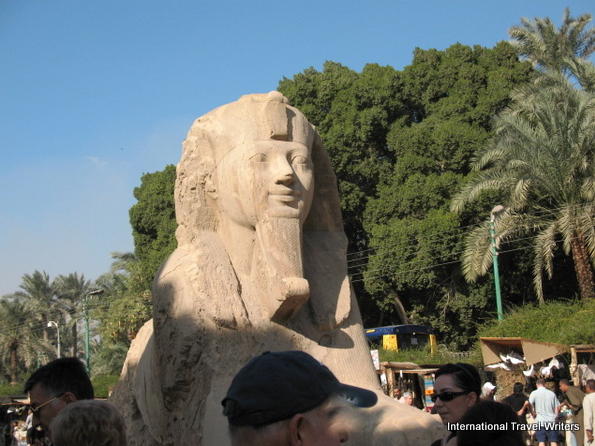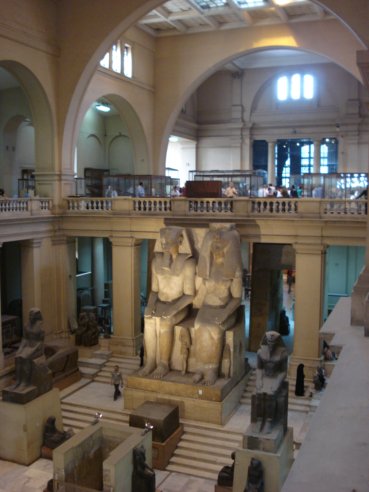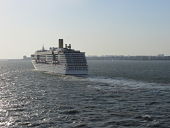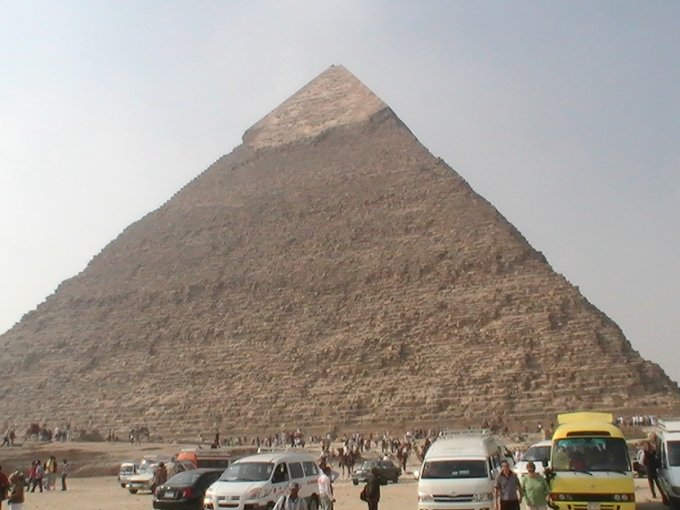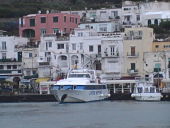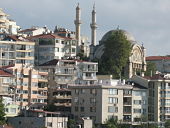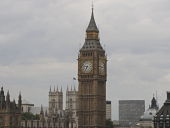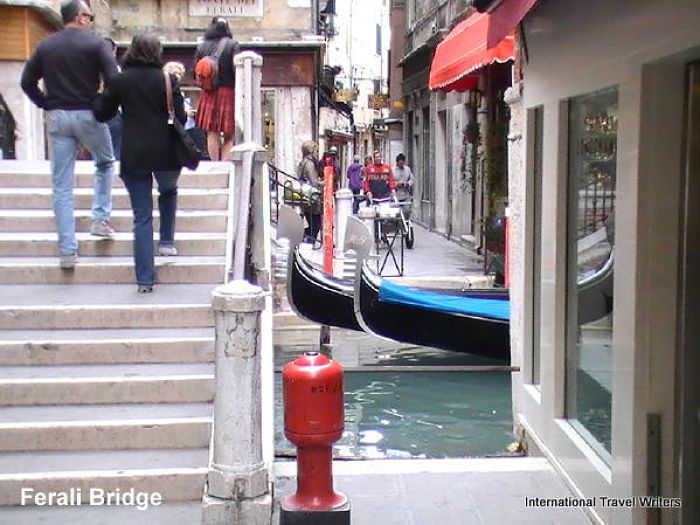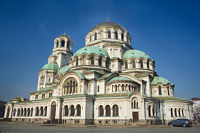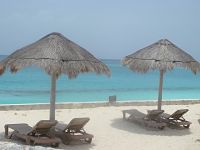Shuffling in the shifting sands of the Great Pyramids of Giza - Egypt

Exploring Egypt's Great Pyramids of Giza and the mysterious Sphinx is a trip well worth
taking. The bus unloaded us at the lower area of the Giza plateau and
the number of tour buses was amazing. There are three major pyramids :
Great Pyramid of Giza, also called the Pyramid of Khufu (Cheops, ca.2600-2550 B.C.) is approx. 481 feet tall, Pyramid of Khafre (Chefren, ca. 2575-2520 B.C.) is approx. 471 feet tall, and Pyramid of Menkaure (Mycerinus, ca.2520-2490 B.C.) is approx. 213 feet tall. Workers were visible doing restorative assignments, trying to keep pace with the devastating damage that the Cairo smog was inflicting on some crumbling areas that preservative measures, hopefully would help.

The Great Pyramid was the tallest man-made structure in the world for over 3,800 years until the Eiffel Tower in 1889. The Great Pyramid was surrounded by a complex of buildings including small pyramids as well as a huge stone wall, Wall of the Crow. Outside of the wall they have found the remnants of mud-brick buildings which they believe is an artisan’s settlement.
The pyramid itself was completely cased in fine, white,
Turah limestone. The Pyramid Temple which was about 171 feet, has
almost entirely disappeared except for some black basalt paving and
limestone walls that have been found. It hasn’t been excavated yet.

At the foot of the Great Pyramid of Giza in Egypt is the Khufu Boat Museum. It houses an intact full-size vessel from Ancient Egypt that was sealed into a pit in the Giza pyramid complex around 2500 B.C. and is believed to have been built for Khufu. It was found in 1954, disassembled but in logical order, in a boat pit. It took years to be reassembled. It is of the type known as a “solar barge”, a ritual vessel to carry the resurrected king with the sun god Ra across the heavens.
However, it has signs of being used in water, so it is possible that the ship was either a funerary “barge” used to carry the king’s embalmed body from Memphis to Giza, or even that Khufu used it as a “pilgrimage ship” to visit holy places and that it was then buried for him to use in the afterlife. Seven boat pits have been identified around the Great Pyramid. Khafre’s pyramid has five boat pits that once contained funeral boats. Unas has two boats.

There are three satellite pyramids popularly known as the Queen’s Pyramids. These three remain standing to nearly full height but the fourth was so ruined it wasn’t discovered until the remains of a capstone surfaced.

Although Khafre’s pyramid in Egypt is shorter than his father Khufu’s Great Pyramid, Khafre made up for it by building at a higher elevation and creating a more elaborate complex. All the elements of a pharaonic mortuary temple are seen in one place for the first time: entrance hall, colonnaded courtyard, niches for royal statuary, storage rooms, and many, many statues including the Sphinx.
Menkaure’s mortuary temple was more elaborate that Khufu’s and instead of the typical limestone walls, Menkaure’s pyramid was covered in pink granite from Aswan on the bottom 15 meters and in the burial chamber. This was a more expensive material and it was also harder to work with. The balance was cased in the traditional white Turah limestone.
However, he
died unexpectedly prior to the completion of his pyramid complex and it
is thought that his heir, Shepseskaf, finished it using mud brick.
After Menkaure, pyramids in Egypt were built on the cheap, meaning
inferior materials were used, on a much smaller scale, and the location
focus changed back to Saqqara where the 1st pyramid was, and nearby
Abusir and Dashur.

The Great Sphinx, or as the ancients knew it, “Shesib Ankh” or “the living image”, was sculpted in place from limestone and it would have disappeared long ago if it hadn’t been buried in sand for so many long periods in its lifetime. This huge, mysterious ancient lion with a human head has evoked a lot of speculation over the millenniums. It has patch signs of its five restorations since 1400 B.C.
The Sphinx is approx. 60 feet tall and 240 feet long. I had seen hundreds, if not thousands of photos and nothing had hit home about how monolithic it was until I was standing alongside and felt like I was the size of an ant.
Nobody knows its original intended name. Sphinx is the human-headed lion in ancient Greek mythology and it is believed that the name likely came into use some 2,000 years after it was built. The face is better preserved than most of the statue which has been subjected to centuries of weathering and vandalism, evidenced by the disfigured features of the face.
Excavations in the early 19th century found pieces of its carved stone beard and a royal cobra emblem from its headdress. Residues of red pigment are still visible on the face, leading some researchers to think that at one time the whole statue was painted red. For thousands of years, sand buried the Sphinx up to its shoulders. In 1817 a Genoese adventurer in Egypt attempted to dig it out, unsuccessfully. In the late 1930’s a local Egyptian archeologist finally managed to unearth it.
Mystery surrounded who built it but it is now generally accepted that Khafre built it in front of his pyramid in his own likeness. In 1853 a life-size statue was unearthed and it bore a startling likeness to Khafre.
It was also discovered that when one stands near the Sphinx during the summer solstice, the sun appears to set midway between the silhouettes of the pyramids of Khafre and Khufu leading some to speculate that there is an astronomical connection involving the sun god which had great importance during that time period in ancient Egypt.

Following our exploration of the pyramid areas with the flat topped tombs called mustabas, the ruins and walking among the grandeur of those huge pyramids, we decided to try camel riding. Along with a couple of adventurous friends we had met on this trip, we hopped aboard camels.
They are on their knees when you mount them and although you feel like you’ll go over his head as he raises himself, it’s actually a lot of fun and quite safe. These camels in Egypt were well behaved and polite, not like an experience in Morocco where a camel tried to bite me and spat all the time


It was now late afternoon and the signal was given to board the bus. We were now leaving Giza and driving back to Cairo. There would be a stop to pick up our items at the jewelry shop. It was uneventful with just simple street scenes visible out the window.
We saw simple Egyptians workers going about their daily chores, apartment buildings and such. The drive from Cairo to the Alexandria area and our ship, the Norwegian Jade, was approximately 3 hours.

However, remember at the beginning of this narrative I said that we always use the ship’s tours because if something happens to make us late returning to the ship, the ship will wait. That’s exactly what happened. I don’t know if the bus air-conditioning constantly laboring for a couple of days had anything to do with it, but when we went to re-board after retrieving our gold cartouches, the engine wouldn’t stay running. We had to wait for another bus to be dispatched to pick us up.

The ship was alerted and they would wait for us. It was pretty dark as we neared the ship and instead of letting us off the bus and walking the length of the pier, the Captain of the Norwegian Jade was on the gangplank waiting! He had obtained permission for the bus to drive right up to the ship. It was an exciting end to a wonderful experience in an ancient and mystic area of Egypt.
Having trouble finding what you need? International Travel Writers Index and Map
OR
Do you have a travel experience or story to share? Share your travels here!
Related Articles.....
Return from Egypt ...Pyramids & Sphinx to International Travel Writers Homepage
By Carolynne Woods, © Copyright 2010-2020. International Travel Writers.com All rights reserved images and text
